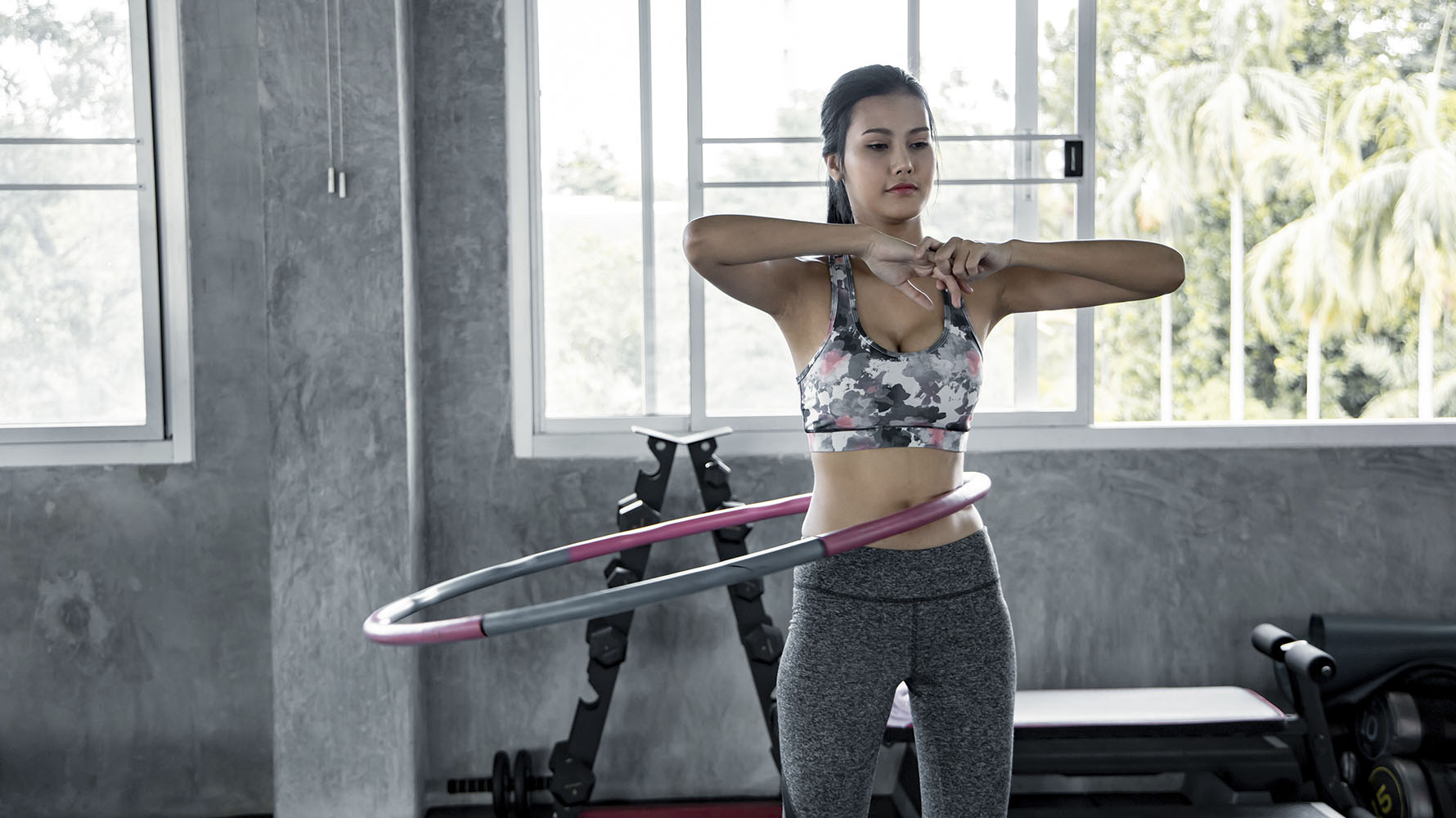For many, the abdomen and sides are considered one of the problematic areas. In the abdominal region, subcutaneous fat deposits often accumulate, which typically is not what you want to see when looking at yourself in the mirror. Finding ourselves in such a situation, we try to find an affordable and effective way to lose those extra pounds. The sports industry comes to the rescue with a variety of weight loss equipment and today we will talk about the hula hoop and how to exercise with it.
Table of Contents
What Determines The Effectiveness of the Hula Hoop Exercise?
The Hula Hoop exercise will help to firm up the abdominal area and sides if the athlete focuses on two important factors: correct eating habits/proper nutrition and additional cardio activities.
Body fat is not burned locally. Weight loss is gradual, so a comprehensive approach that combines intense aerobic exercise, and a low-carb diet is needed to achieve quick results.
Principles of Nutrition for Fat Burning
Your diet should be based on plant foods, lean proteins and “complex” carbohydrates. At the same time, it is best to eat the latter up until lunch. After 13.00 all side dishes should be replaced with vegetables and salads.
Recommended ratio of protein, fat and carbohydrates: 40–20–40. The total calorie count of your daily diet should not exceed 1800 calories a day.
You need to eat in small portions 4-6 times a day. It is also advisable to completely exclude sweet and starchy foods from the diet. By following these guidelines and exercising regularly, you can create a calorie deficit, that will help reduce body fat.
Cardio
The Hula Hoop exercise is not intense and too energy consuming. You can increase the number of calories burned by an order of magnitude by adding 2-3 aerobic workouts per week to your daily exercise routine.
Choose the discipline you like and enjoy and by doing so, you do not have to force yourself to exercise, and the training itself will be fun and enjoyable. The best cardio exercise for burning fat is running, plyometrics, bicycle riding, nordic walking, dance aerobics, game sports, ski and skating.
How to Choose a Hula Hoop?
We may have all become accustomed as a child with lightweight aluminum or plastic hula hoops. But such models are only suitable for gymnastics and for the development of the musculoskeletal system in children. Specialized hula hoops should be used to target subcutaneous fat:
- It has significantly more weight than a simple aluminum one (from 2 to 8 lbs). Thanks to this, the core muscles receive an effective load and the athlete achieves their weight loss goals faster.
- The main feature is the presence of plastic or rubber “spikes” on the inner surface of the hula hoop. This design has a positive effect on the subcutaneous fatty tissue and improves blood circulation.
- This hula hoop is similar in appearance to massage, but has one addition. Magnets are built into its body and the field created by them helps to increase blood flow in the abdominal area, and also has a decongestant and analgesic effect.
- It has a flexible metal base covered with a dense thick layer of rubber on top. Such a hula hoop can not only be twisted at the waist, but also bend in different directions, which allows you to work out many different muscle groups.
You may find bruising on your sides after your first weighted hula hoop workouts. Don’t worry, it’s okay. As soon as the body gets use to the unusual stress, bruising will stop.
In the initial stages, we recommend wearing tight/tight belly high-waisted clothing or jeans. This will help reduce any adverse effects of the equipment on the skin.

How to Do The Hula Hoop Exercise?
We recommend that you master the basic technique if you are just starting to practice with the hula hoop:
- Starting position: the feet are in line of the shoulders or slightly wider, the legs are straight, the back is straight, the arms are bent at the elbows and raised to chest level.
- Standing straight, spin the hula hoop around the waist. When you feel the hula hoop slow down and begin to descend, lightly swing your hips to give it extra momentum and rotation.
- Breath normally and don’t hold your breath, otherwise you will lose rhythm and the hula hoop will drop.
Keep your abdominal muscles under constant tension. If you try to spin the hula hoop on a relaxed waist, there will be no effect.
Start exercising with 10-15 minutes a day, gradually increasing the duration. Ideally, the training interval you should aim for should last 35-40 minutes. Number of training sessions per week: 5-6. After mastering the simple twist, make the exercises harder with different leg positions or use a heavier hula hoop.
Hula Hoop Workout for Weight Loss
Here we will look at an aerobic workout with a hula hoop. It is aimed at quickly getting rid of extra pounds. You will need a weighted hula hoop for this type of training. Put on some energetic music and get started!
- Stand in the center of the hula hoop, holding it with your hands at the level of the groin. Begin to march vigorously in place. At the same time, raise the hula hoop above the head and return it back to the hips. Move for 1 minute. Then lower the hula hoop down (to the groin) and start walking left and then right. Simultaneously while walking, raise and lower your shoulders. Repeat for 60 seconds.
- Stand up straight, stretch arms out with a hoop in front of. Feet should be the width of the pelvis. Squat down to a right angle between the thigh and lower leg and raise the hula hoop above the head. Then quickly return to the starting position. Squat like this for 30 seconds.
- With the legs spread slightly wider than the shoulders, hold the hula hoop in front of and close to the body. Step the right foot to the left and push the equipment to the left. Return to the starting position and repeat in the opposite direction. Move rhythmically without pauses for 1 minute.
- Hold the hula hoop with straight arms in front of you. Bring your right leg back and lower your body into a reverse lunge. At the same time, twist the body and arms to the left. Return to the starting position and repeat with the other leg. Continue for 30 seconds.
- Stand up straight. Place your feet close together and rotate the hula hoop at your waist. Spread your arms out to the sides. Continue for 2 minutes. Keep the rhythm and try to avoid the hula hoop from dropping. Then, without stopping, slowly turn around in a circle. Continue like this for another 60 seconds clockwise and back again.
- Lie on your back. Bend your legs and press your feet to the floor. Pick up the hula hoop and lift it above your chest. As you exhale, twist your upper body and contract your abs. Stretch your arms as high as possible. Continue for 30 seconds.
- Standing with feet about 20-30 inches apart. Rotate the hula hoop at your waist quickly. Keep your arms bent at chest level, then add alternating light steps to the twist. Lift your right foot 4-6 inches from the ground, then repeat with your left foot. Keep moving for 1 minute.
- Place the hula hoop on the floor next to your hip. Sit down abruptly and move through it. Straighten up and repeat the movement in the opposite direction. Perform the exercise for 30 seconds.
- Stand up straight and quickly rotate the hula hoop around your waist. Optionally, you can add turns to the sides or a light walk on the spot. This is the final part of the workout and choose the duration yourself. It is recommended to start with 10 minutes and gradually increase the time.
Perform all exercises one after the other without pauses. Exercise at least 5 times a week. Duration of 1 lap: 20-25 minutes. If this is not enough, then perform 2 cycles in a row. To enhance the effect of the exercise, apply a fat-burning cream to the waist area and put on a special belt for weight loss before starting the workout.

What Are The Benefits of Hula Hoop Exercise?
The main advantage of the hula hoop exercise is as a high-quality workout of the muscles of the abs, back, buttocks, hips, as well as small stabilizers. The equipment is great for beginners and home fitness use. In addition, hula hoop contributes to:
- increase the flexibility of the spine;
- maintaining physical activity for many years;
- posture correction;
- strengthening the cardiovascular system;
- improving intestinal motility;
- reduction of subcutaneous fat;
- getting rid of cellulite.
Contraindications
Medical contraindications for the hula hoop exercise is pregnancy and the first 2 months after birth, abdominal surgery, infections of the internal organs during periods, heart failure, and musculoskeletal injuries.
